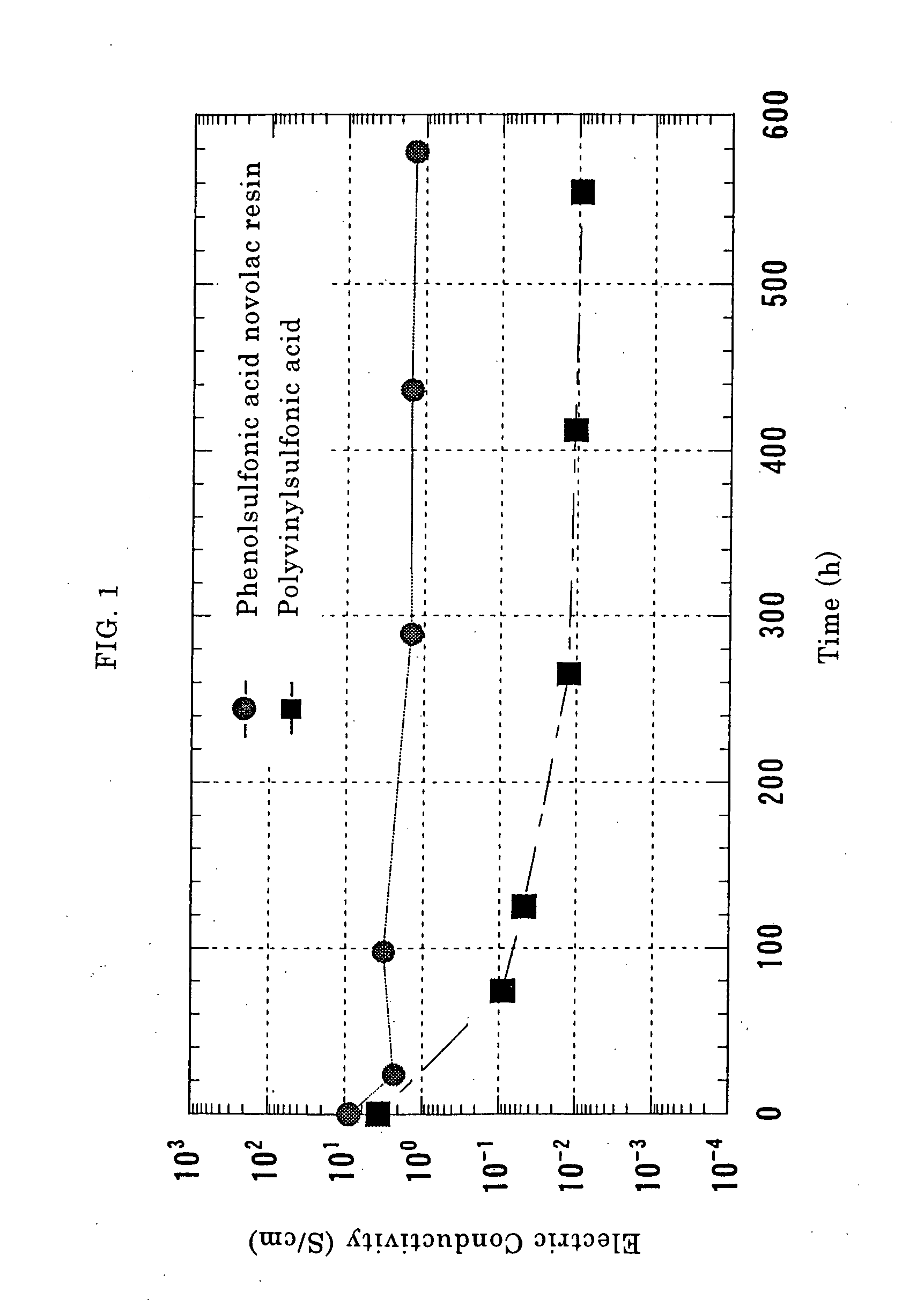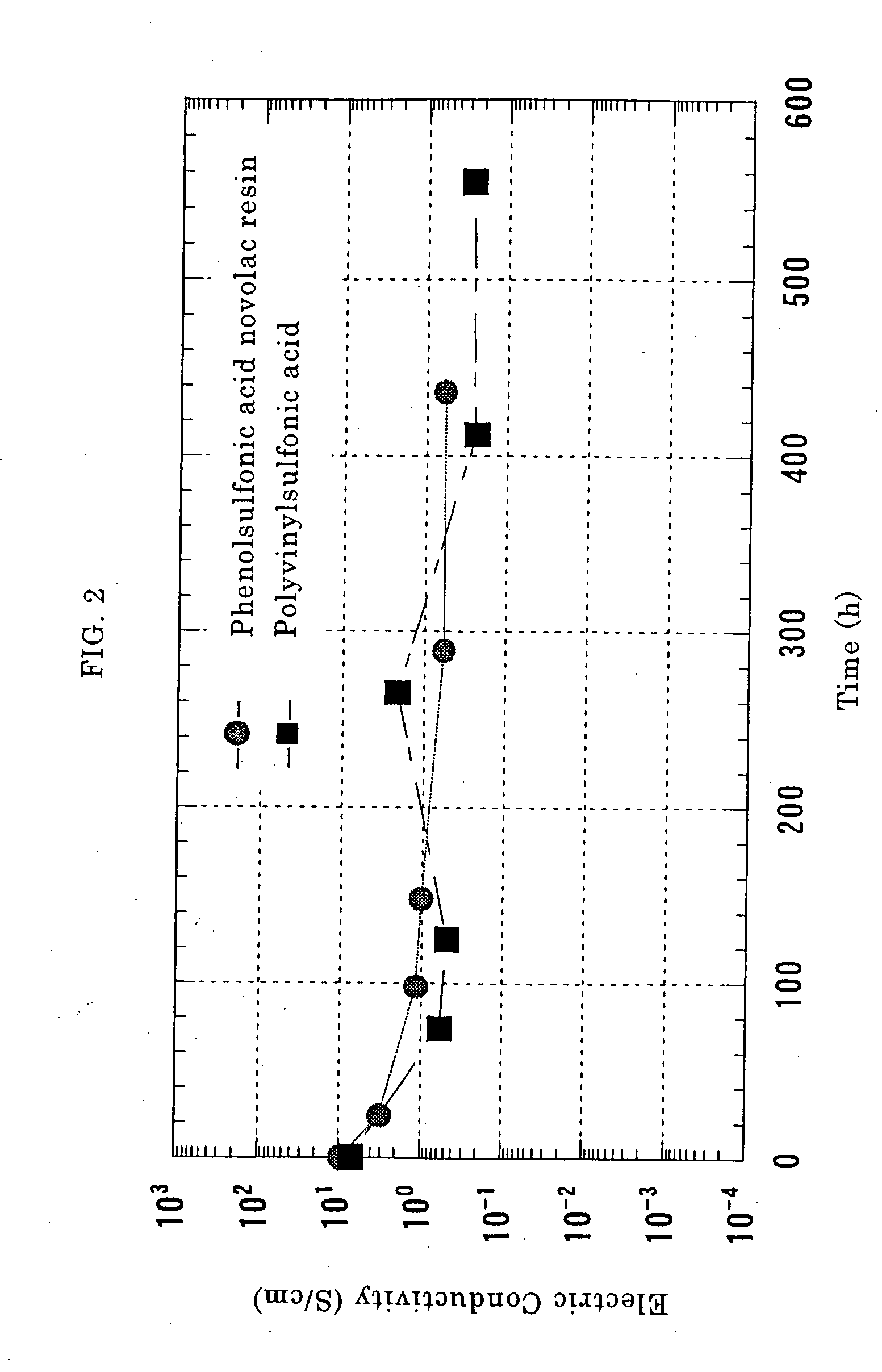Conductive polyaniline composition, film thereof and processes for producing these
a technology of conductive polyaniline and composition, applied in the direction of non-metal conductors, conductors, organic chemistry, etc., can solve the problems of insufficient water resistance of electricly conductive polyaniline composition, and inevitable decrease of electric conductivity of composition to a certain degree, so as to achieve superior water resistance and heat resistance
- Summary
- Abstract
- Description
- Claims
- Application Information
AI Technical Summary
Benefits of technology
Problems solved by technology
Method used
Image
Examples
reference example 1
(The Production of an Electrically Conductive Polyaniline Composition by Oxidation Polymerization of Aniline)
6000 g of distilled water, 360 mL of 36%-hydrochloric acid and 400 g (4.295 mol) of aniline were charged in this order into a 10 L-capacity separable flask provided with a stirring apparatus, a thermometer and a straight tube adapter and the aniline was dissolved in the aqueous solution of hydrochloric acid. 434 g (4.295 mol) of 97%-concentrated sulfuric acid was added to and mixed with 1493 g of distilled water in a beaker while cooled by iced water to prepare an aqueous solution of sulfuric acid. The aqueous solution of sulfuric acid was added to the above-mentioned separable flask and the total flask was cooled to a temperature of −4° C. in a low-temperature controlled bath. Then, 980 g (4.295 mol) of ammonium peroxodisulfate was added to and dissolved in 2293 g of distilled water in a beaker to prepare an aqueous solution of an oxidizing agent.
While stirring and reta...
reference example 2
(The Production of Reduced and Dedoped Polyaniline)
2.5 g of powder of the oxidized and dedoped polyaniline obtained in Reference Example 1 was added to 97.5 g of N-methyl-2-pyrrolidone and dissolved therein while stirred, and 0.82 g of phenylhydrazine was gradually added to this solution. Then, the solution changed in color from deep blue to light dark brown, and concurrently the generation of nitrogen gas was confirmed.
After the reaction, the reaction mixture was dropped into 1.5 L of acetone substituted with nitrogen to provide precipitate in light gray. The precipitate was collected by filtration with a glass filter and washed with acetone substituted with nitrogen several times and thereafter dried under reduced pressure at room temperature to provide 2.3 g of reduced and dedoped aniline comprising an imino-p-phenylene structural unit as powder in light gray. The polyaniline thus obtained was found to have an intrinsic viscosity [η] of 1.1 dL / g measured in N-methyl-2-pyrrol...
example 1
10 g of powder of the oxidized and dedoped polyaniline obtained in Reference Example 1 was dissolved in 90 g of N-methyl-2-pyrrolidone to prepare a 10% by weight-solution. Four sheets of pressure-sensitive adhesive tapes having a thickness of 120 μm were stuck in piles on both ends of an A4-size glass plate so as to form a bank, and the solution of polyaniline in N-methyl-2-pyrrolidone was cast thereon, drawn through a glass rod and thereafter dried at a temperature of 80° C. for 1 hour in a hot-air circulating type drier. The polyaniline film thus obtained was peeled off the glass plate. The thickness of the polyaniline film thus obtained was 42 μm. Three sheets of 1 cm-square films were cut out of this film.
An aqueous solution of p-phenolsulfonic acid novolac resin (available from Konishi Chemical Industry Co., Ltd., and having a weight-average molecular weight of 20000 calculated in terms of sodium polystyrene sulfonate as a result of GPC measurement) was prepared at a solids ...
PUM
| Property | Measurement | Unit |
|---|---|---|
| temperature | aaaaa | aaaaa |
| electrically conductive | aaaaa | aaaaa |
| water resistance | aaaaa | aaaaa |
Abstract
Description
Claims
Application Information
 Login to View More
Login to View More - R&D
- Intellectual Property
- Life Sciences
- Materials
- Tech Scout
- Unparalleled Data Quality
- Higher Quality Content
- 60% Fewer Hallucinations
Browse by: Latest US Patents, China's latest patents, Technical Efficacy Thesaurus, Application Domain, Technology Topic, Popular Technical Reports.
© 2025 PatSnap. All rights reserved.Legal|Privacy policy|Modern Slavery Act Transparency Statement|Sitemap|About US| Contact US: help@patsnap.com



